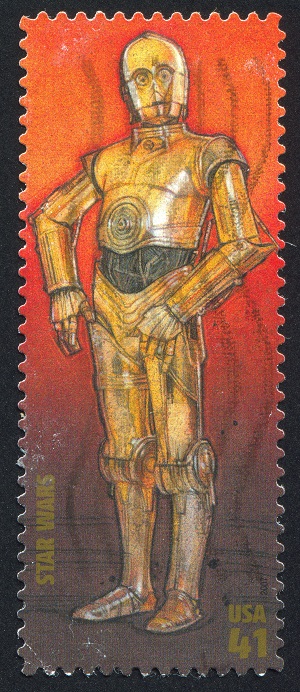19 Mar Fuzzy Logic Section Intro
 Why do we find Mr. Spock, Commander Data or C3P0 so lovable? We have all known people like them: they are the ones who see the world in black and white. Spock had an excuse – he was a Vulcan who knew a lot. Computers, on the other hand, can be downright exasperating when they get stuck in stupid patterns that require us to make everything black or white, exactly right, then spit out garbage when it’s not. Human communication, language and cognition is fuzzy by nature, just as much in nature is fuzzy by design. In earlier sections of this blog we discussed the physical mechanisms of thought and understanding. This section moves us further into the abstract realms of hopes and dreams.
Why do we find Mr. Spock, Commander Data or C3P0 so lovable? We have all known people like them: they are the ones who see the world in black and white. Spock had an excuse – he was a Vulcan who knew a lot. Computers, on the other hand, can be downright exasperating when they get stuck in stupid patterns that require us to make everything black or white, exactly right, then spit out garbage when it’s not. Human communication, language and cognition is fuzzy by nature, just as much in nature is fuzzy by design. In earlier sections of this blog we discussed the physical mechanisms of thought and understanding. This section moves us further into the abstract realms of hopes and dreams.
“the physical material is absolutely necessary for normal thinking to tick along. If you were to injure your pinkie in an accident you’d be distressed, but your conscious experience would be no different. By contrast, if you were to damage an equivalently sized piece of brain tissue, this might change your capacity to understand music, name animals, see colors, judge risk, make decisions, read signals from your body, or understand the concept of a mirror—thereby unmasking the strange, veiled workings of the machinery beneath. Our hopes, dreams, aspirations, fears, comic instincts, great ideas, fetishes, senses of humor, and desires all emerge from this strange organ—and when the brain changes, so do we. So although it’s easy to intuit that thoughts don’t have a physical basis, that they are something like feathers on the wind, they in fact depend directly on the integrity of the enigmatic, three-pound mission control center” (Eagleman 2012).
The mechanics of electrical transmission in the human neural network, as described in other sections of this blog, support fuzzy processes and outcomes. Yet there seem to be missing links in our understanding of consciousness and judgment. Enter the Mind. Does it exist? What is it made of? How does it interact with the brain? I have no answers for these questions but I’d like to bring you along with me as I look for a scientific basis for this vexing dichotomy. I will also probe into several other areas of cognition and theory, including the implications of “Threshold Logic” to fuzzy logic.
| Understanding Context Cross-Reference |
|---|
| Click on these Links to other posts and glossary/bibliography references |
|
|
|
Multi-Valued Logic
 We humans can integrate multiple constraints and propositions into our thinking processes in the absence of complete information. We can take incorrect information and sort it out to make good decisions. The way the brain we does this apparently logical (based on the logical outcomes) but pretty fuzzy (lots of varied electrical impulses running around creating bubbles of comprehension). The way computers imitate this is by using fuzzy logic. Fuzzy logic assumes that there may be shades between black and white, good and bad, important and trivial. As we saw in the first sections of this blog on the nervous system, the brain is pretty fuzzy. Its huge network of neurons is able to process hundreds or thousands of different angles on any problem. Each synapse connecting neurons is also fuzzy in that the amount of electrical flow may vary dramatically, depending on the input (constraints). The bubbling up of conscious thoughts is the fuzziest process of all, and it is not well understood.
We humans can integrate multiple constraints and propositions into our thinking processes in the absence of complete information. We can take incorrect information and sort it out to make good decisions. The way the brain we does this apparently logical (based on the logical outcomes) but pretty fuzzy (lots of varied electrical impulses running around creating bubbles of comprehension). The way computers imitate this is by using fuzzy logic. Fuzzy logic assumes that there may be shades between black and white, good and bad, important and trivial. As we saw in the first sections of this blog on the nervous system, the brain is pretty fuzzy. Its huge network of neurons is able to process hundreds or thousands of different angles on any problem. Each synapse connecting neurons is also fuzzy in that the amount of electrical flow may vary dramatically, depending on the input (constraints). The bubbling up of conscious thoughts is the fuzziest process of all, and it is not well understood.
Cybernetics
 In this section, we consider the nature of information and different forms of logic. We look at how humans think and process information, exploring what we can do for computers to make them smart like Spock or Data yet resourcefully flexible like Captain Jean-Luc Picard or James T. Kirk. This picture is a dangerously pointy (not fuzzy) Aloe Vera plant in a Mayan village near Costa Maya, Mexico. The parents placed egg shells over the points to protect their rambunctious kids from being injuriously impaled. They chose to keep the plant because they used it for beautifying the yard, as well as harvesting the healing oil. Could a machine ever figure out this clever way to protect children? Could a machine ever identify the danger before witnessing an injury? These questions go way beyond the Turing test, but I will try to address this in my exploration.
In this section, we consider the nature of information and different forms of logic. We look at how humans think and process information, exploring what we can do for computers to make them smart like Spock or Data yet resourcefully flexible like Captain Jean-Luc Picard or James T. Kirk. This picture is a dangerously pointy (not fuzzy) Aloe Vera plant in a Mayan village near Costa Maya, Mexico. The parents placed egg shells over the points to protect their rambunctious kids from being injuriously impaled. They chose to keep the plant because they used it for beautifying the yard, as well as harvesting the healing oil. Could a machine ever figure out this clever way to protect children? Could a machine ever identify the danger before witnessing an injury? These questions go way beyond the Turing test, but I will try to address this in my exploration.
| Click below to look in each Understanding Context section |
|---|
| Intro | Context | 1 | Brains | 2 | Neurons | 3 | Neural Networks |
| 4 | Perception and Cognition | 5 | Fuzzy Logic | 6 | Language and Dialog | 7 | Cybernetic Models |
| 8 | Apps and Processes | 9 | The End of Code | 10 | Glossary | 11 | Bibliography |








